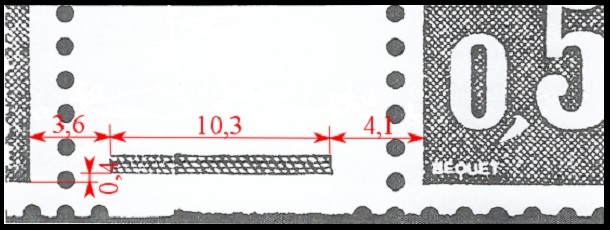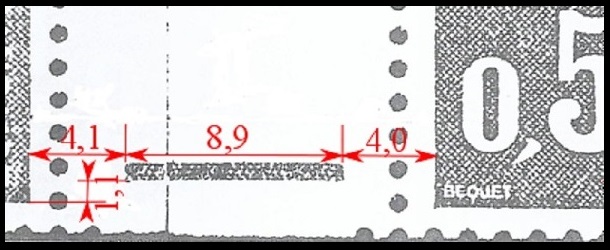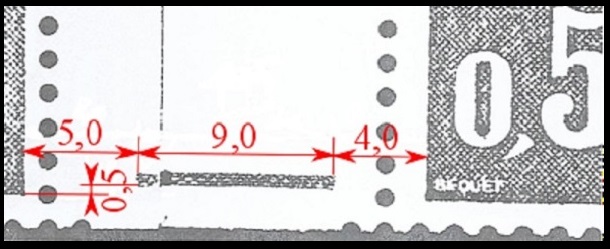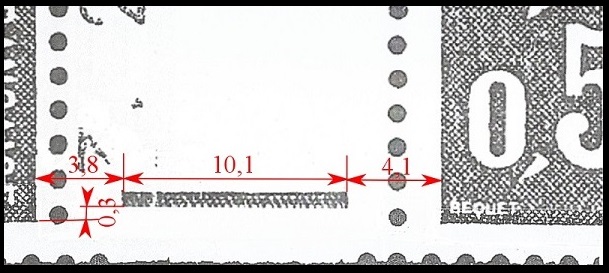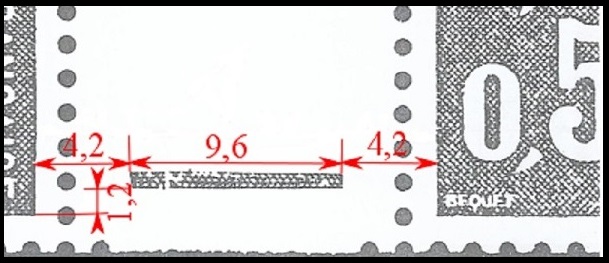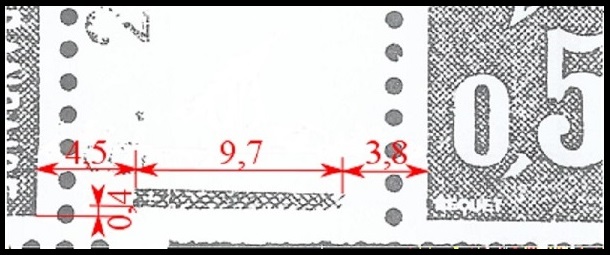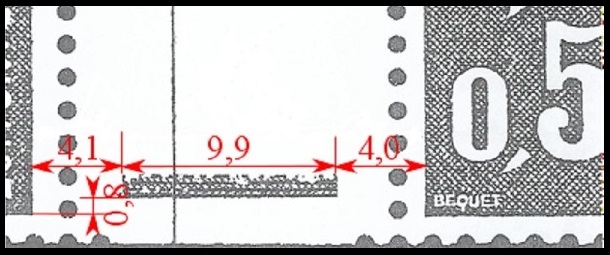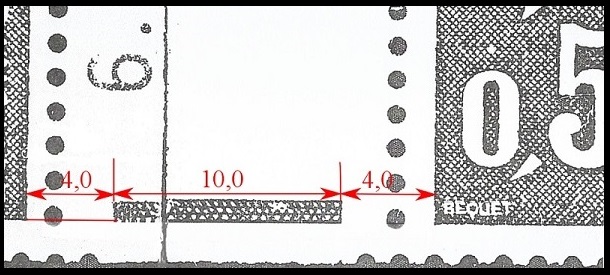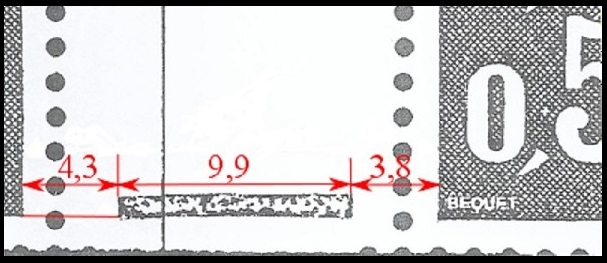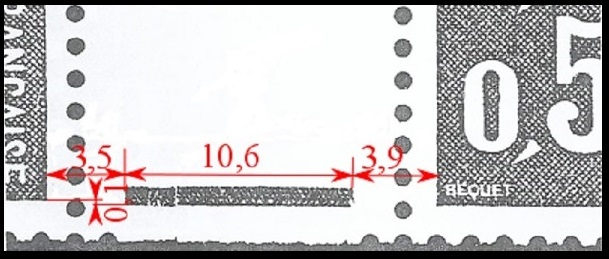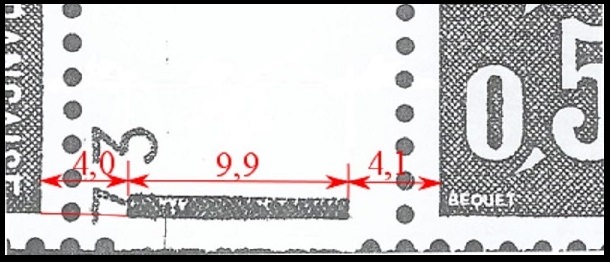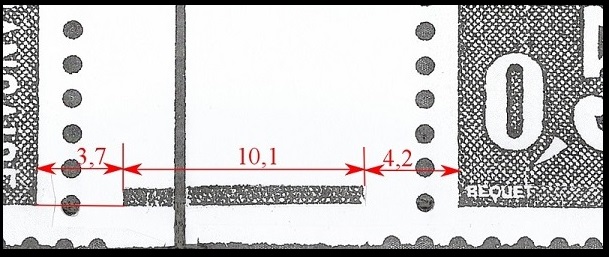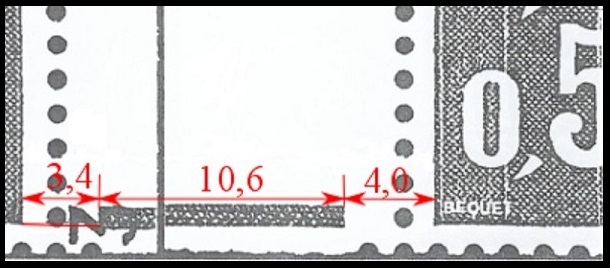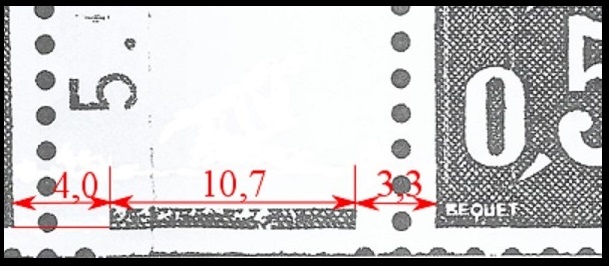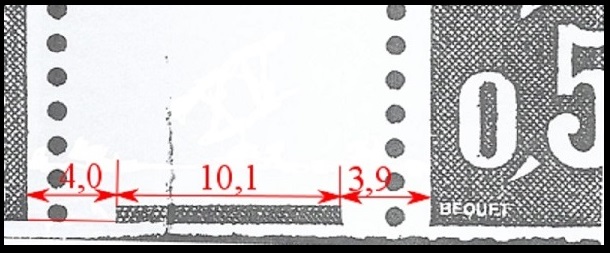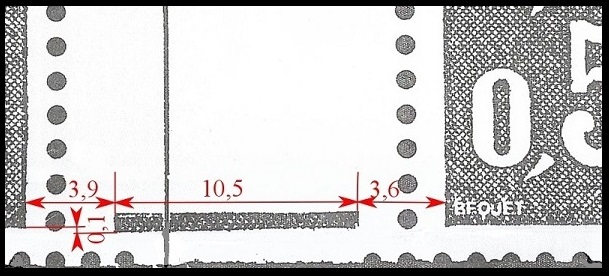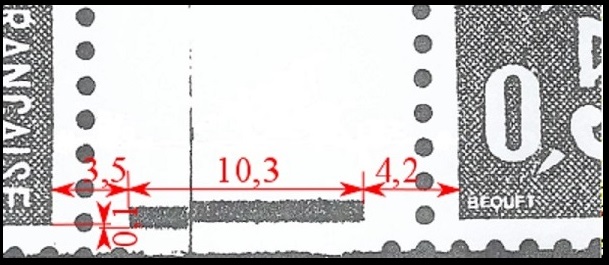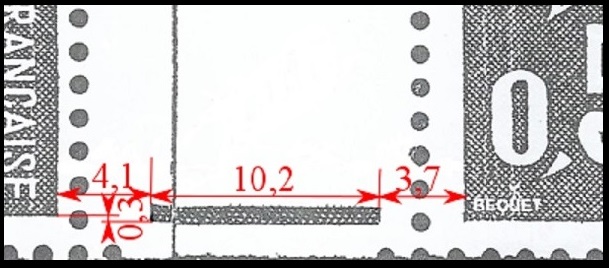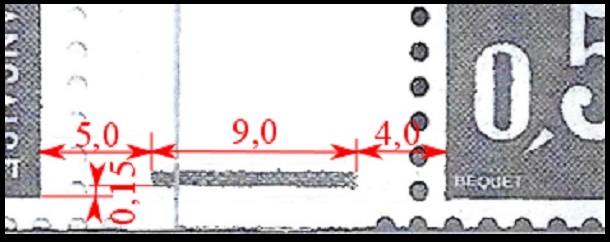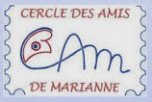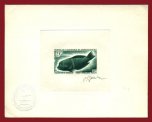
Sommaire
Introduction
Closed and folded booklets of 10 and 20 stamps 0,50F Marianne de Béquet, with or without phosphor bands, were produced with three types of cover: “Caisse d’Épargne Postale”, “Code postal sans trait” and “Code postal avec trait”. This gives a total of ten different types of booklets, numbered here C1 to C10 (as in some catalogues).
We will now describe and illustrate these various types of booklets, by supplying all known information about these booklets: used presses, gravure printing cylinders and packaging machines. Mentioned dates are those known to day, for example according to the Cours des carnets de l’ A.C.C.P.. There is no guarantee, however, that these dates cannot be improved.
We will also show some varieties about these booklets, which can be extremely spectacular. This is due to the way in which these booklets are made: booklets arrive closed in front of the checking person and booklets with missing colour, defective printing, misperforations,... can completely escape the attention of the printing office staff and thus can be found in post offices.
We will end this article by proposing some test booklets linked to those containing stamps 0,50F Marianne de Béquet, as well as two booklets produced for the PTTs postal courses.
Presses used
Stamps 0,50F Marianne de Béquet were printed on the presses TD6-3, 6-4, 6-5, 6-6 and 6-7 for the booklets of 10 stamps:

- booklet of 10 stamps whose stamps have been produced on the TD6-3 press

- booklet of 10 stamps whose stamps have been produced on the TD6-4 press

- booklet of 10 stamps whose stamps have been produced oh the TD6-5 press

- booklet of 10 stamps whose stamps have been produced on the TD6-6 press

- booklet of 10 stamps whose stamps have been produced on the TD6-7 press
and on the presses TD6-3, 6-5, 6-6 and 6-7 for the booklets of 20 stamps:
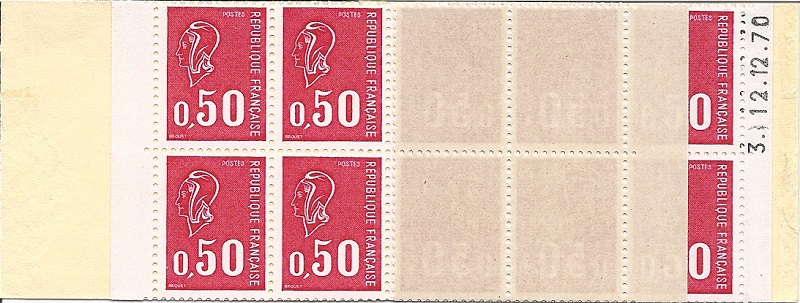
- booklet of 20 stamps whose stamps have been produced on the TD6-3 press
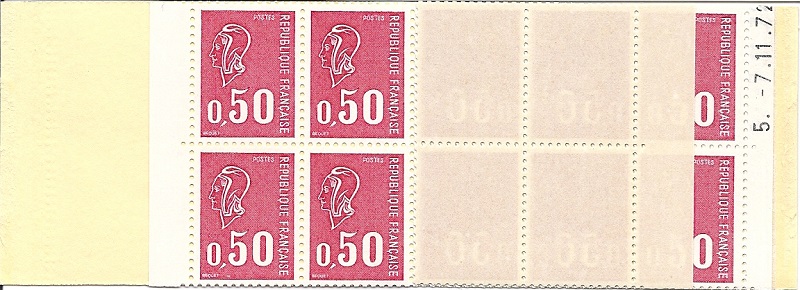
- booklet of 20 stamps whose stamps have been produced on the TD6-5 press
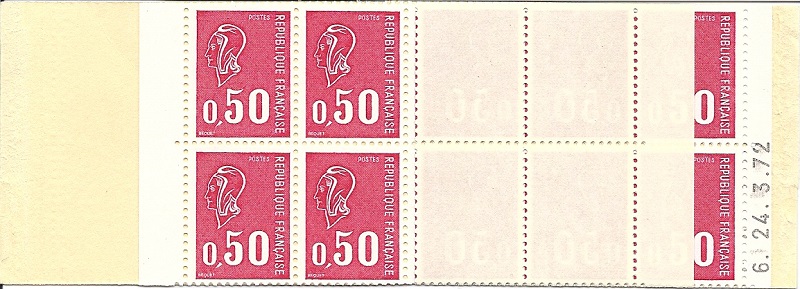
- booklet of 20 stamps whose stamps have been produced on the TD6-6 press
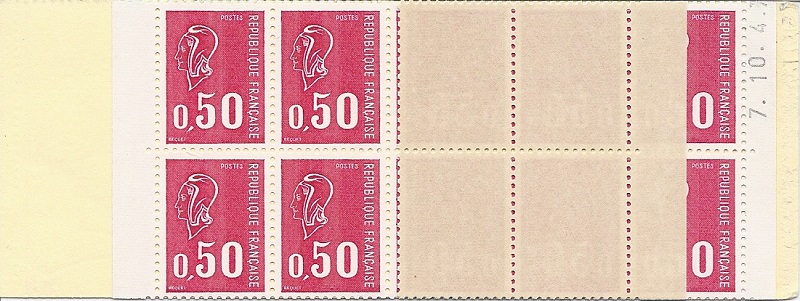
- booklet of 20 stamps whose stamps have been produced on the TD6-7 press
Gravure printing cylinders used
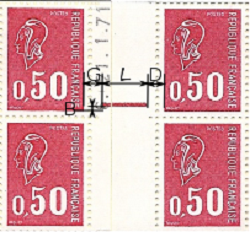
- characterisation of the graving printing cylinder of a booklet
Nineteen gravure printing cylinders served to print the stamps for these booklets. We will first describe their characteristics, according to the brochure Les carnets 0,50F Marianne de Béquet by J. RENARD.
But first, let us recall how these gravure printing cylinders are characterized: for every electronic mark associated with a gravure printing cylinder, four parameters, measured in millimetres and denoted L, D, G and B, are defined, according to the opposite figure.
The gravure printing cylinders used to produce the stamps having served for the preparation of booklets can be described by the following table:
B=0,4 | ||||
B=1,1 | ||||
B=0,5 | ||||
B=0,3 | ||||
B=1,2 | ||||
B=0,4 | ||||
B=0,8 | ||||
B=0,0 | ||||
B=0,0 | ||||
B=- 0,1 | ||||
B=0,0 | ||||
B=0,0 | ||||
B=0,0 | ||||
B=0,0 | ||||
B=0,0 | ||||
B=- 0,1 | ||||
B=- 0,1 | ||||
B=- 0,3 | ||||
B=0,15 |
The gravure printing cylinder number 19 was belatedly discovered (cf. J. RENARD’s article in the Bulletin du C.A.M.). Logically, it should have been numbered between 1 and 5. I have no other information about this gravure printing cylinder than its parameters.
I am now going to provide, in tabular form, an enlarged reproduction of all the electronic marks of these gravure printing cylinders, thanks to the brochure sur les carnets du 0,50F Marianne de Béquet by J. RENARD.
Packaging machines used
The covers of booklets were produced on the packaging machines number 1, 2, 3, 4, 5, 6, 7 and 8. Besides, there was a printing cylinder without number which could serve as replacement on any packaging machine. So, a number of covers of booklets do not possess packaging machine’s number (in what follows, I will refer to a packaging machine without number for this case, even if this term is inaccurate).
The ten types of issued booklets
The C1 type booklet
It is a booklet of 10 stamps without phosphor band, with a cover advertising the “Caisse d’Épargne Postale”:

- cover of the C1 booklet produced by the packaging machine number 5

- inside of the above booklet: it is an "aristo" booklet made on the press TD6-6 on 10.12.70 with the electronic mark number 2
Booklets C1 were produced from 04.12.70 to 06.05.72 through the presses TD6-3, 6-4, 6-5 and 6-6. Covers were printed through the packaging machines number 1, 2, 3, 4, 5, 7 and 8.
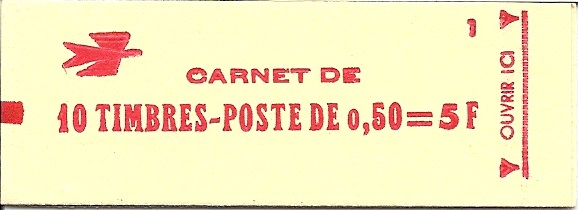
- C1 booklet produced by the packaging machine number 1
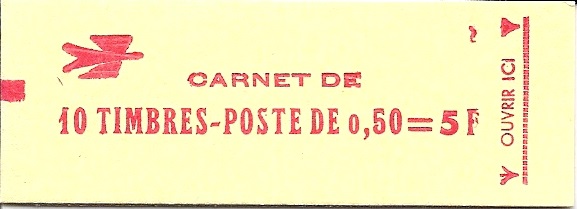
- C1 booklet produced by the packaging machine number 2
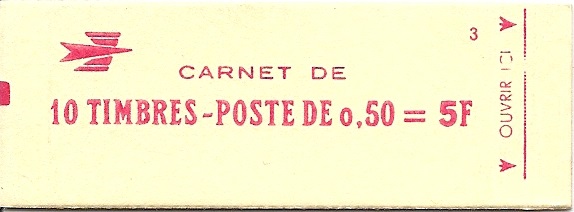
- cover of a C1 booklet produced on the packaging machine number 3
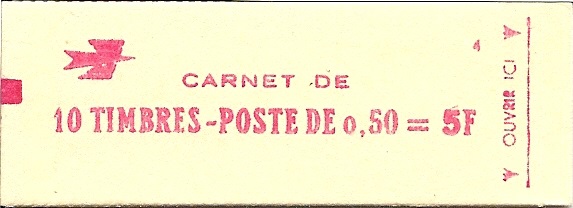
- C1 booklet produced by the packaging machine number 4
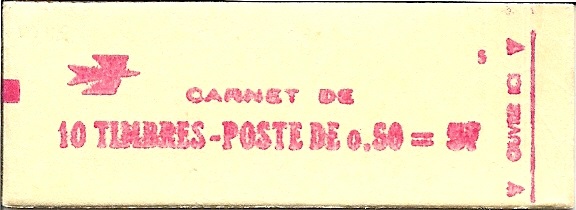
- C1 booklet produced by the packaging machine number 5
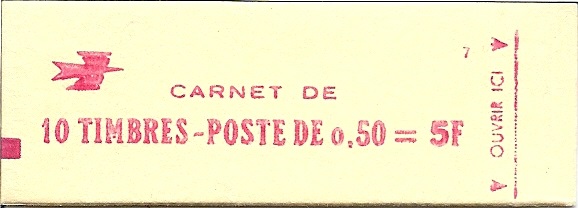
- C1 booklet produced by the packaging machine number 7
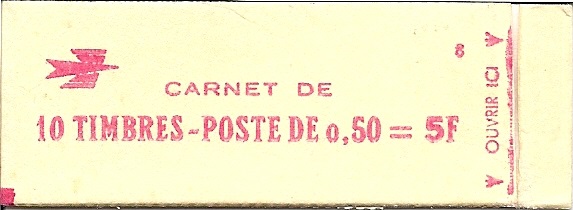
- C1 booklet produced by the packaging machine number 8
Here are finally some varieties affecting C1 type booklets:

- straddling guillotining of a C1 booklet

- cover of the above booklet

- upper pane of a C1 booklet with 8 defective printed stamps

- lower pane of a C1 booklet with 8 defective printed stamps

- cover of the above booklet
The C2 type booklet
It is a booklet of 20 stamps without phosphor band, with a cover advertising the “Caisse d’Épargne Postale”:
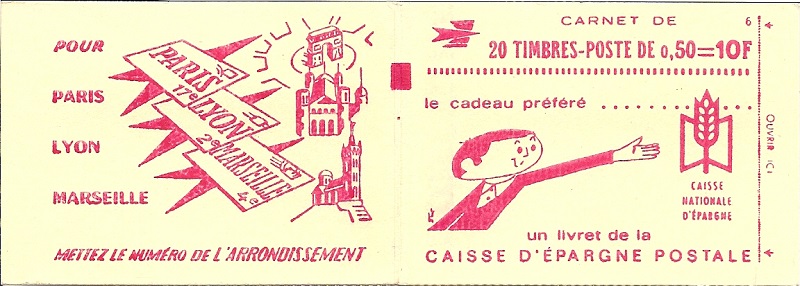
- cover of the C2 booklet produced by the packaging machine number 6
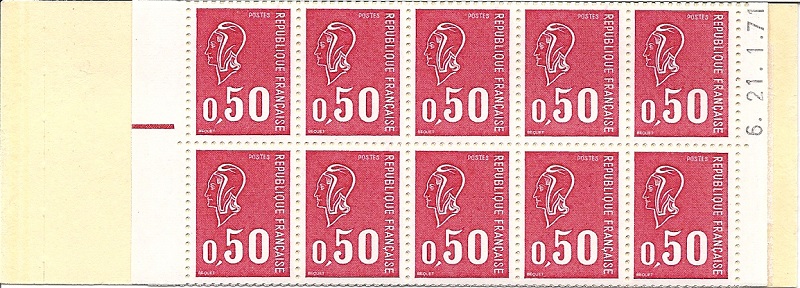
- the upper pane of the above booklet: it is an "aristo" booklet made on the press TD6-6 on 21.1.71 with the electronic mark number 2
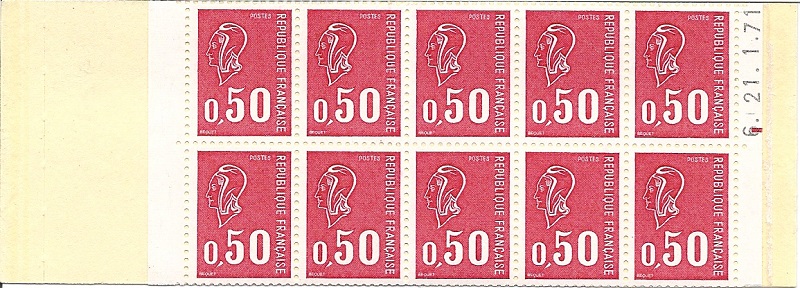
- the lower pane of the above booklet (the end of the electronic mark can be seen on the right)

- reconstitution of the sheet of the above booklet showing the complete electronic mark
C2 type booklets were produced from 08.12.70 to 18.05.72 on the presses TD6-3, 6-5 and 6-6. Covers were printed through the packaging machines number 6, 7 and 8.
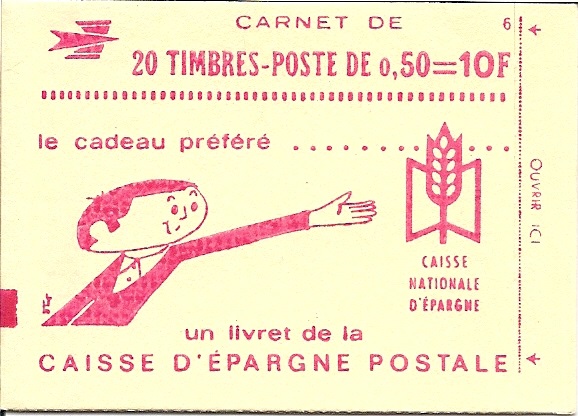
- C2 booklet produced by the packaging machine number 6
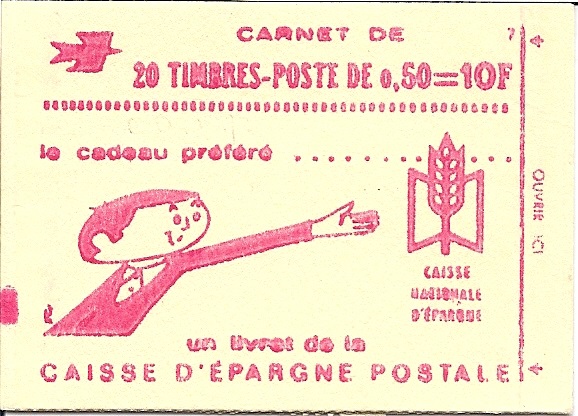
- C2 booklet produced by the packaging machine number 7
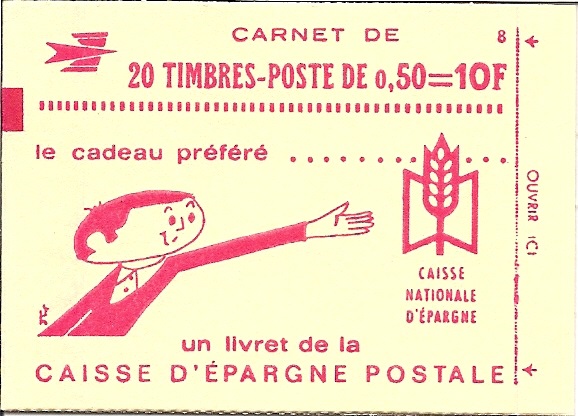
- C2 booklet produced by the packaging machine number 8
Here is now a variety concerning a C2 type booklet:
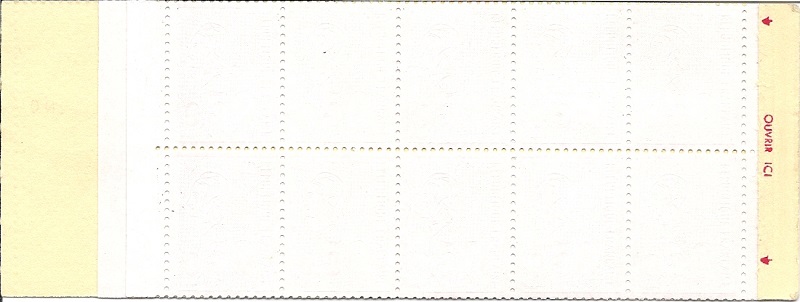
- upper pane of a C2 booklet with 20 albinos
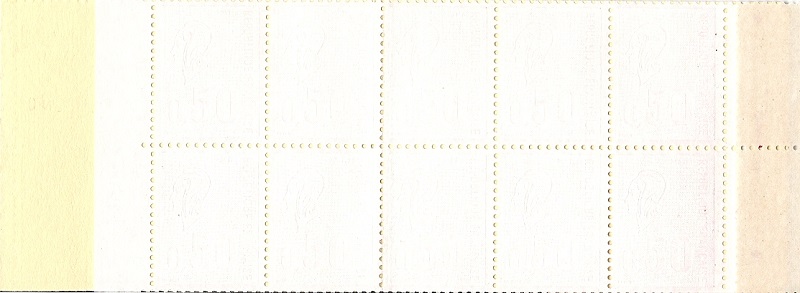
- lower pane of a C2 booklet with 20 albinos
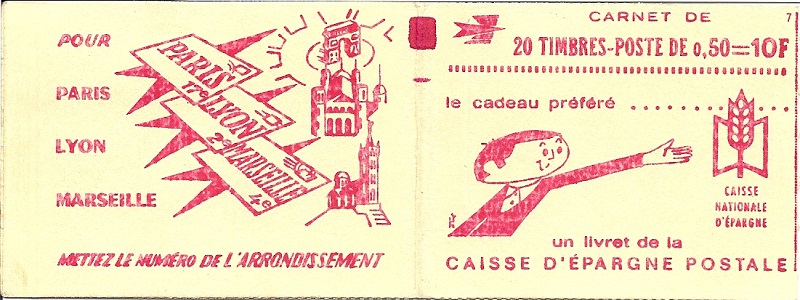
- cover of the above booklet
The C3 type booklet
It is a booklet of 10 stamps without phosphor band, with a cover advertising the use of the 5-digit zip code introduced in March, 1972, without dotted lines:

- cover of the C3 booklet produced by the packaging machine number 5

- inside of the above booklet: it is an "aristo" booklet made on the press TD6-6 on 20.2.73 with the electronic mark number 8
C3 type booklets were produced from 02.05.72 to 11.04.73 on the presses TD6-5 and TD6-6. Covers were printed through the packaging machines number 3, 4, 5 and 7:
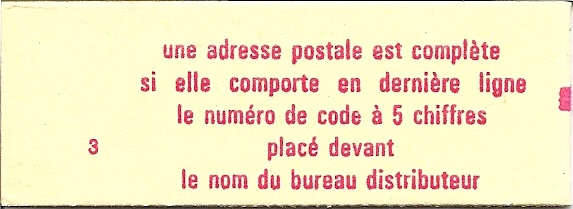
- cover of the C3 booklet produced by the packing machine number 3
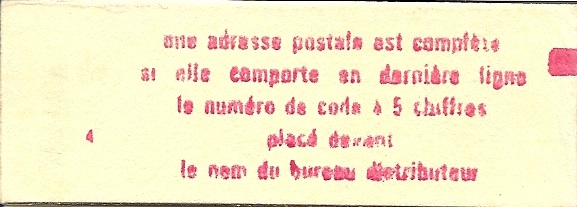
- cover of the C3 booklet produced by the packing machine number 4
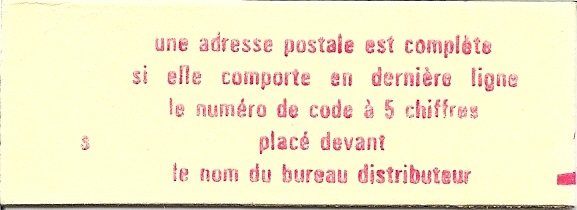
- cover of the C3 booklet produced by the packing machine number 5
The C4 type booklet
It is a booklet of 10 stamps without phosphor band, with a cover advertising the use of the 5-digit zip code, with dotted lines added to inform the user of the side from which it is necessary to open the booklet:

- cover of the C4 booklet produced by the packing machine number 2

- inside of the above booklet
C4 type booklets were produced from 28.02.73 to 17.04.73 on the presses TD6-5 and TD6-6. Covers were printed through the packaging machines number 1 and 2.
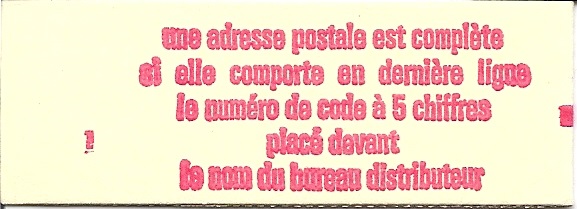
- C4 booklet produced by the packing machine number 1
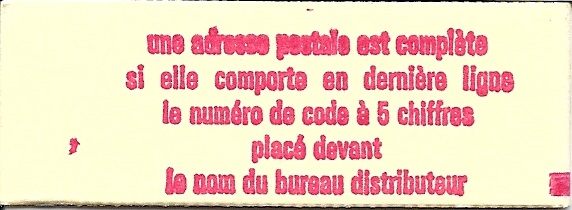
- C4 booklet produced by the packing machine number 2
The C5 type booklet
It is a booklet of 20 stamps without phosphor band, with a cover advertising the use of the 5-digit zip code, without dotted lines:
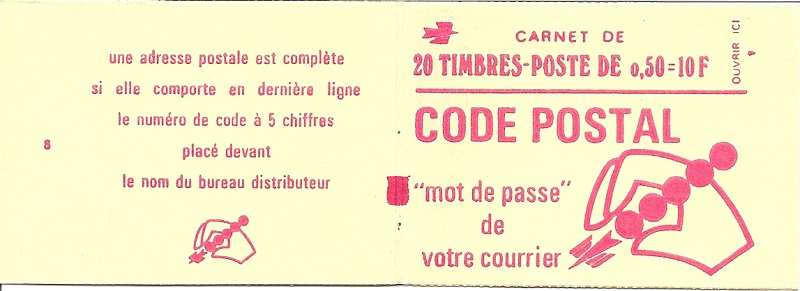
- cover of the C5 booklet produced by the packaging machine number 8
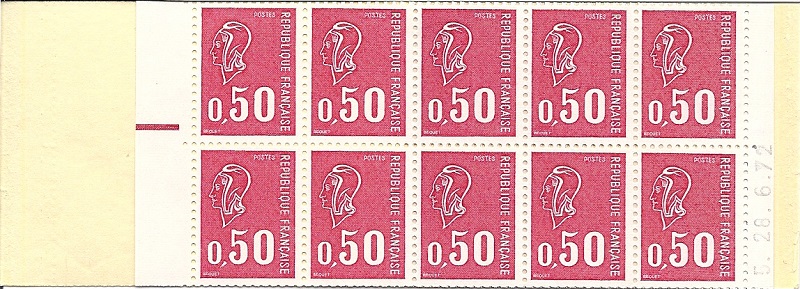
- inside of the above booklet: it is an "aristo" booklet made on the press TD6-5 on 26.6.72 with the electronic mark number 7
C5 type booklets were produced from 06.06.72 to 07.04.73 on the presses TD6-5 and TD6-6. Covers were printed through the packaging machines number 6 and 8.
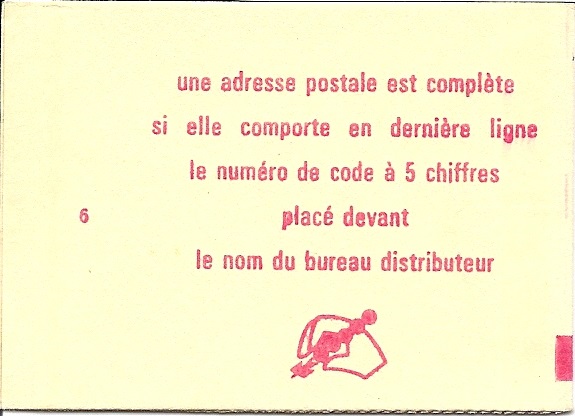
- C5 booklet produced by the packaging machine number 6
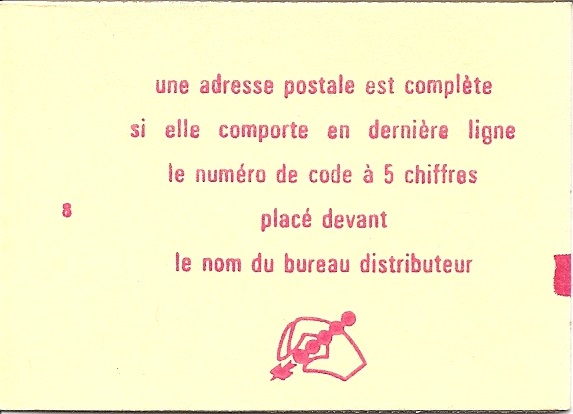
- C5 booklet produced by the packaging machine number 8
Here is now a C5 type booklet with defective printing stamps:
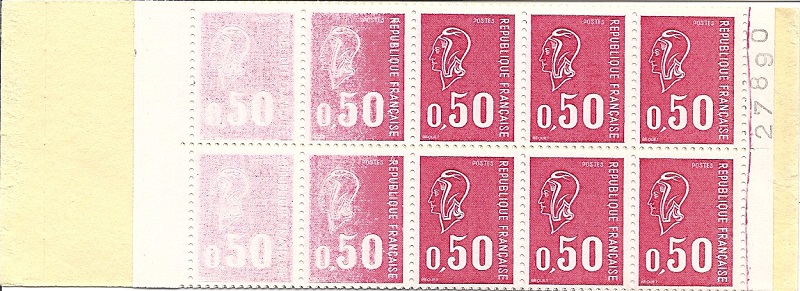
- upper pane of a C5 booklet with 6 defective printed stamps
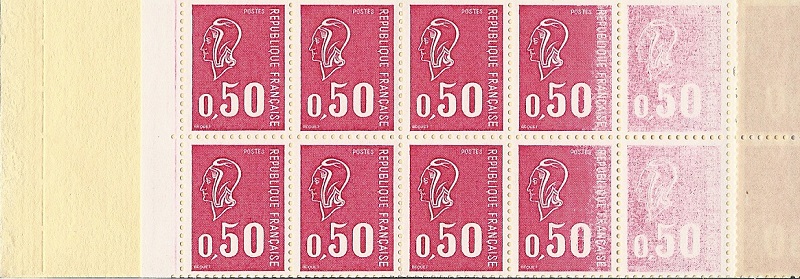
- lower pane of a C5 booklet with 6 defective printed stamps
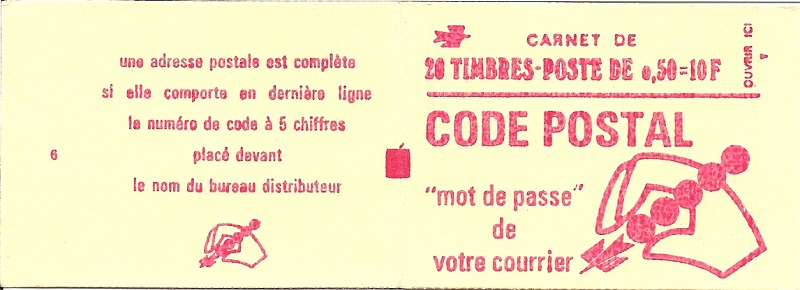
- cover of the above booklet
The C6 type booklet
It is a booklet of 20 stamps without phosphor band, with a cover advertising the use of the 5-digit zip code, with dotted lines:
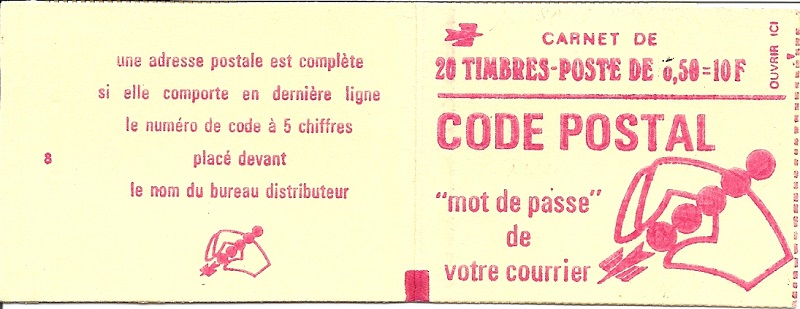
- cover of the C6 booklet produced by the packaging machine number 8
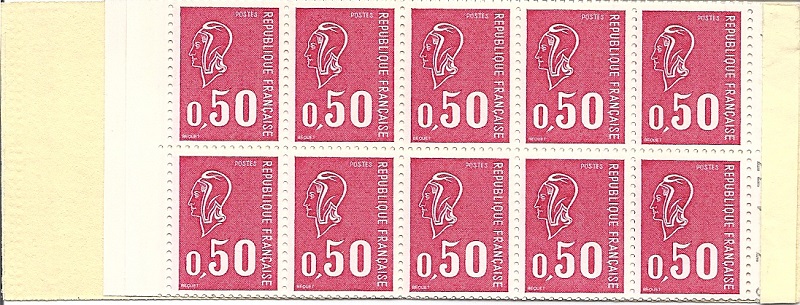
- inside of the above booklet: booklet dated 3.1.73
C6 type booklets were produced on 31.5.72, 3.1.73 and 17.11.73 on the press TD6-5. Covers were only printed on the packaging machine number 8.
The C7 type booklet
It is a booklet of 10 stamps with three type B phosphor bands and a cover advertising the use of the 5-digit zip code, without dotted lines:

- cover of the C7 booklet produced by the packaging machine number 5

- inside of the above booklet dated 2.1.73
C7 type booklets were produced from 02.01.73 to 26.07.74 on the presses TD6-4, 6-5, 6-6 and 6-7. Covers were printed through the packaging machines with number 3, 4, 5 and 7 and without number.
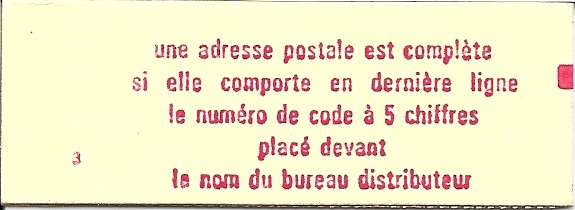
- cover of the C7 booklet produced by the packaging machine number 3
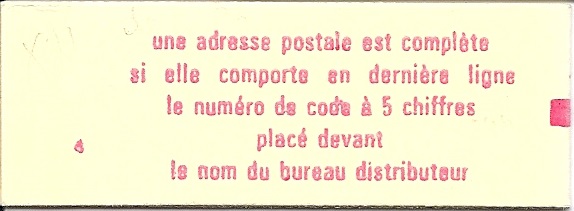
- cover of the C7 booklet produced by the packaging machine number 4
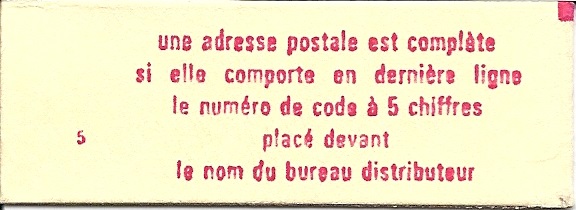
- cover of the C7 booklet produced by the packaging machine number 5
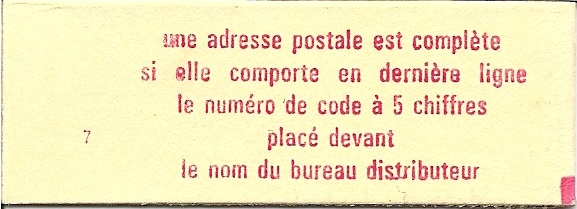
- cover of the C7 booklet produced by the packaging machine number 7
Here is finally a C7 type booklet with 10 albinos:

- upper pane of a C7 booklet with 10 albinos

- lower pane of a C7 booklet with 10 albinos

- cover of the previous booklet
The C8 type booklet
It is a booklet of 10 stamps with three type B phosphor bands and a cover advertising the use of the 5-digit zip code, with dotted lines:

- cover of the C8 booklet produced by the packaging machine number 2

- inside of the above booklet: booklet dated 31.7.74
C8 type booklets were produced from 14.02.73 to 31.07.74 on the presses TD6-5, 6-6 and 6-7. Covers were printed through the packaging machines number 1 and 2 and without number.
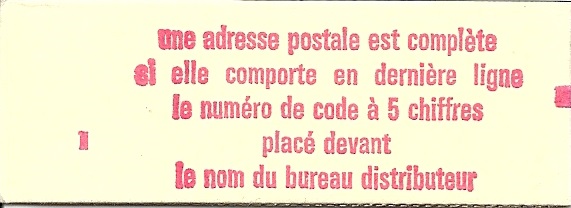
- C8 booklet produced by the packaging machine number 1
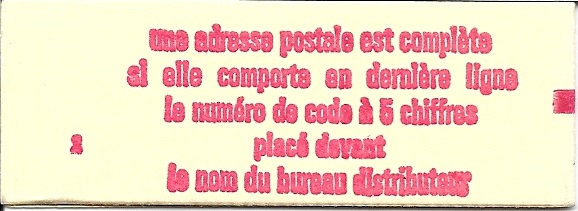
- C8 booklet produced by the packaging machine number 2
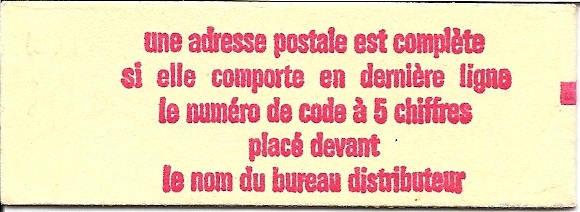
- C8 booklet produced by the packaging machine without number
The C9 type booklet
It is a booklet of 20 stamps with three phosphor bands and a cover advertising the use of the 5-digit zip code, without dotted lines:
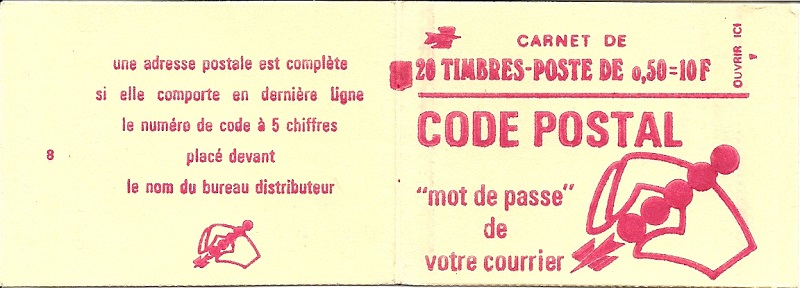
- cover of the C9 booklet produced by the packing machine number 8
C9 type booklets have a peculiarity: they are the only ones among all the booklets with stamps 0,50F Marianne de Béquet to have been produced with two types of phosphor bands:
Type A bands
Some C9 type booklets with three type A phosphor bands can be found in the French Postal Museum’s archives. Here are two pictures of these booklets:
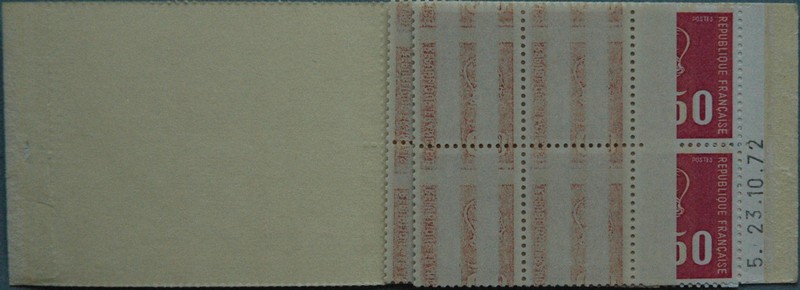
- un-issued C9 booklet dated 23.10.72 (Source : Copyright Coll. L’Adresse Musée de La Poste, Paris / La Poste)
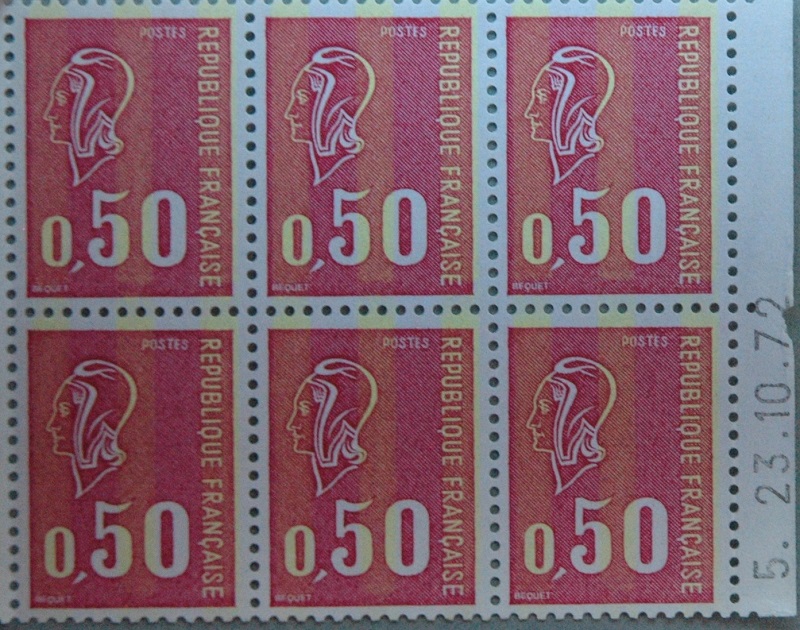
- photo under UV of the stamps of the above booklet showing the type A phosphor bands
This booklet, dated 23.10.72, arises from the press TD6-5. We may see, on the upper image, phosphor ink traces on the reverse side of the stamps: it is ink rub-off due to the not still dry ink of the previous turn of the reel. This date of 23.10.72 was never found in post offices. It is thus probably an unissued booklet.
On the other hand, booklets produced from 04.12.72 to 05.12.72 with three type A phosphor bands are known:
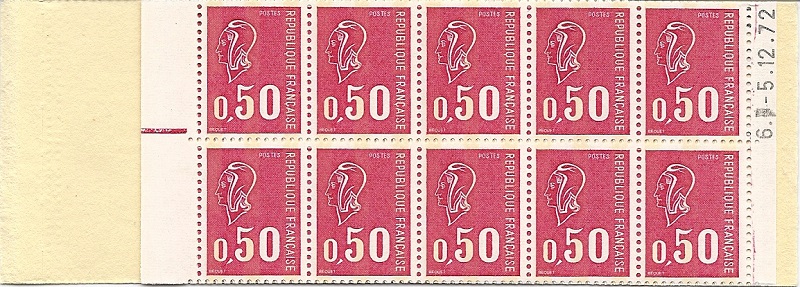
- inside of a C9 booklet with type A phosphor bands: it is an "aristo" booklet made on the press TD6-6 on 5.12.72 with the electronic mark number 8
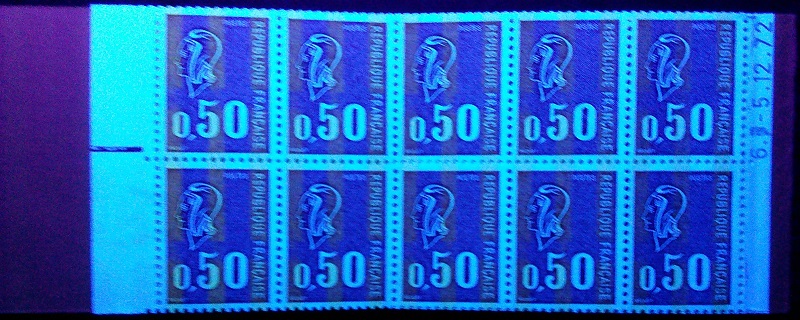
- photo under U.V. of the above booklet: phosphor bands have a vertical offset of approximately 50%
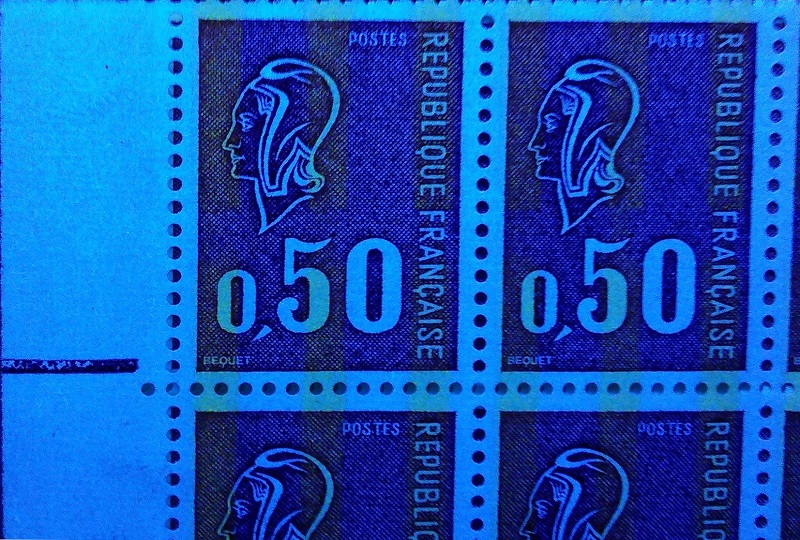
- enlargement of the stamps of the above booklet under U.V. showing the vertical offset of the phosphor bands
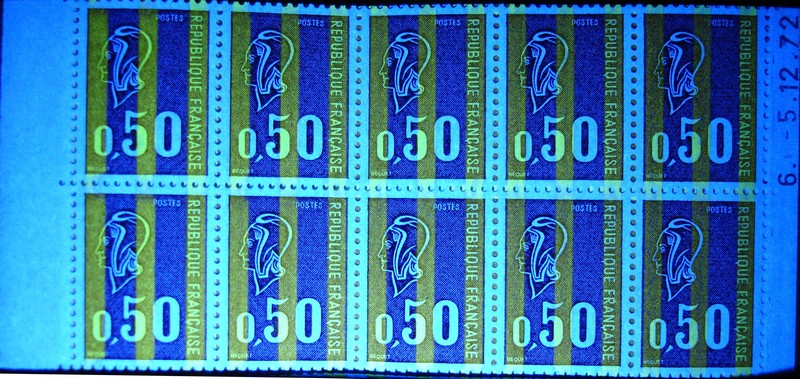
- photo under U.V. of a C9 booklet with normal type A phosphor bands

- reconstitution of the sheet of a C9 booklet showing the complete electronic mark 8
Personally, I have only seen such booklets with a cover made on the packaging machine number 8.
Here is finally a curious booklet: the upper pane has phosphor bands horizontally and vertically shifted, giving two stamps with only 2 phosphor bands and phosphor bands printed in the left margin; the lower pane is normal:
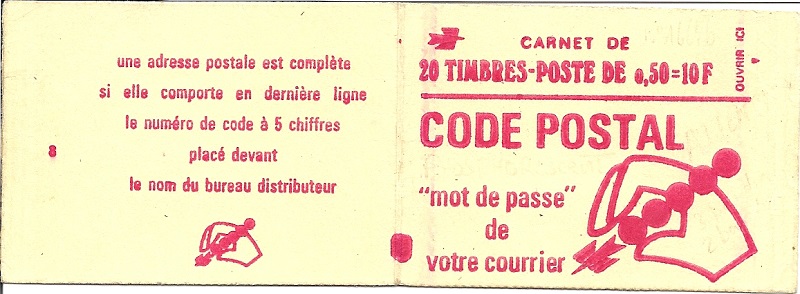
- cover of a C9 booklet produced on the packaging machine number 8
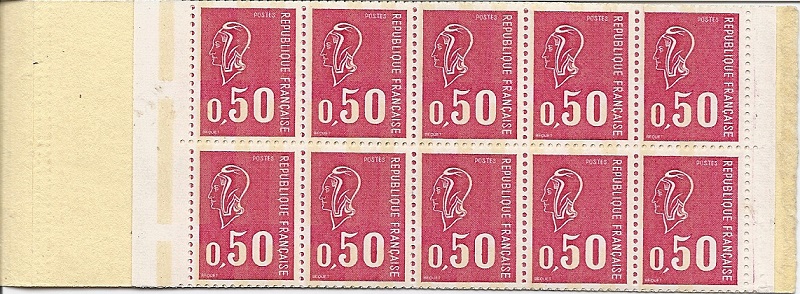
- upper pane of the previous booklet: the offset phosphor bands can be seen on the left margin
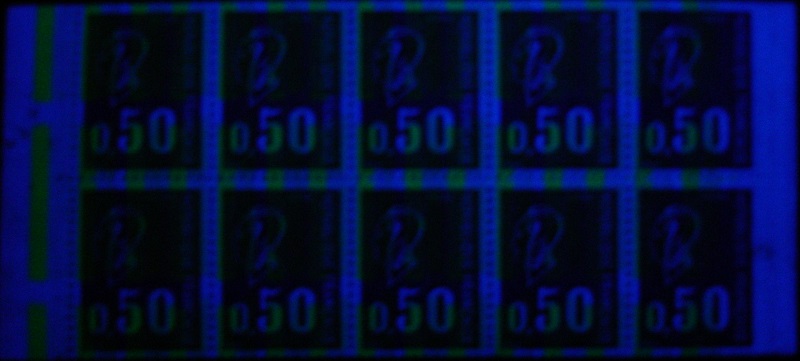
- photo under UV of the above booklet
Type B bands
All the other known printings for the C9 type booklet are with three type B phosphor bands. They were printed on the presses TD6-5, 6-6 and 6-7, from 02.01.73 to 31.05.74.
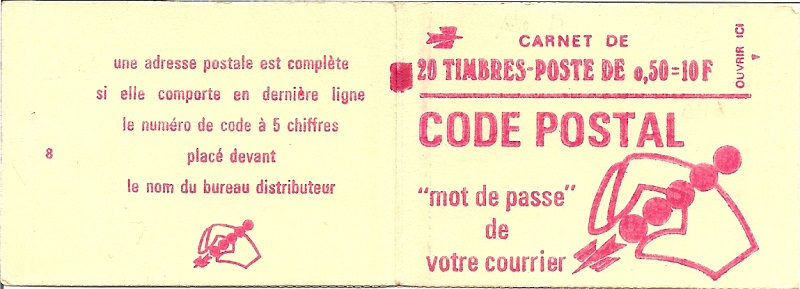
- cover of the C9 booklet produced by the packaging machine number 8
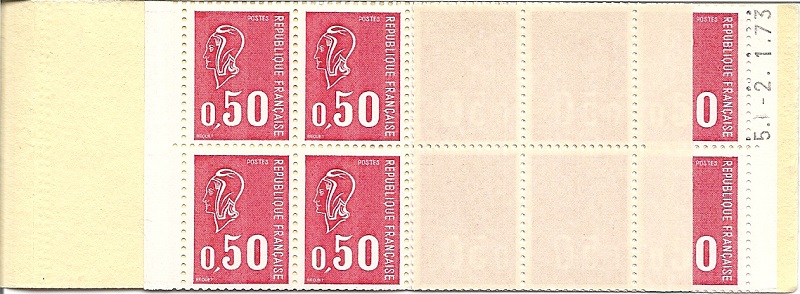
- inside of the above booklet: booklet dated 2.1.73 (first day issue of the stamps with type B phosphor bands?)
Here is another C9 type booklet with really recognizable type B phosphor bands:
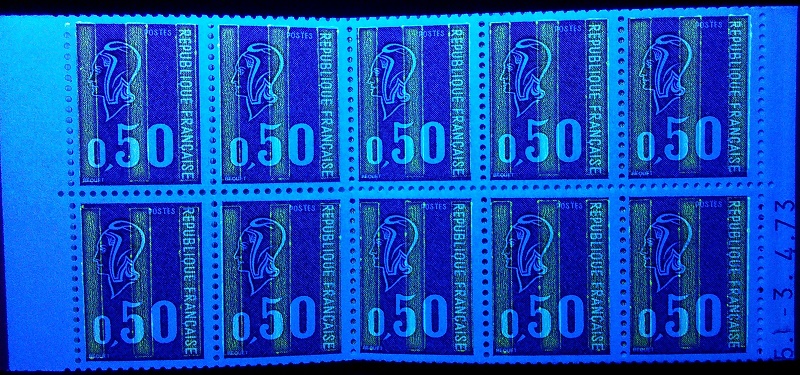
- photo under UV of a C9 booklet with type B phosphor bands
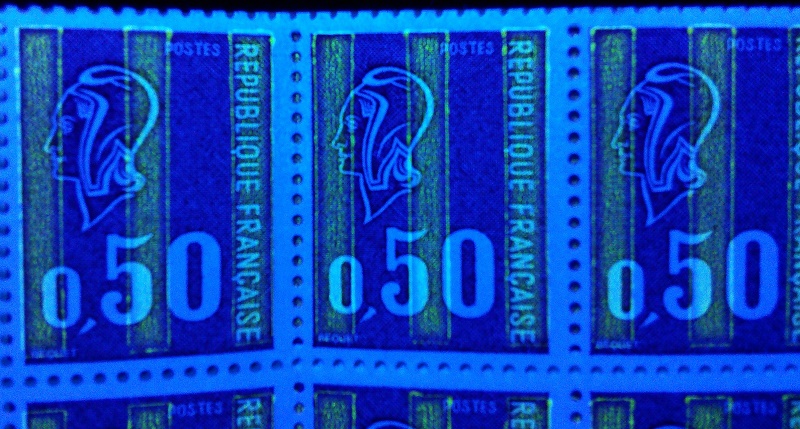
- enlargement of 2 stamps of the above booklet
Covers were printed through the packaging machines number 6, 8 and without number.
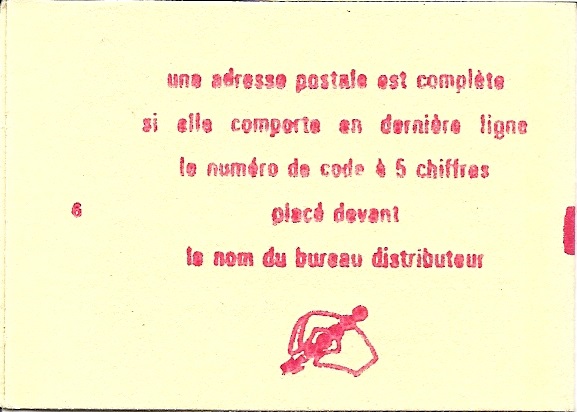
- C9 booklet produced by the packaging machine number 6
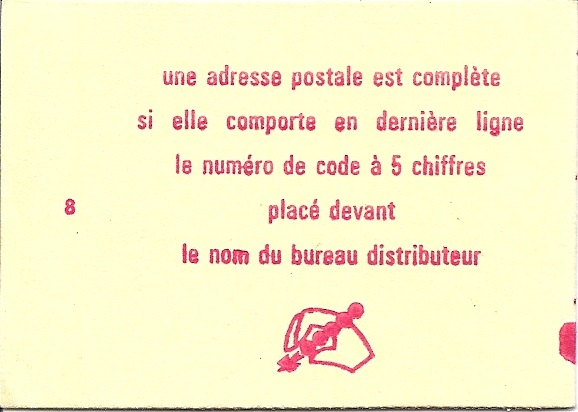
- C9 booklet produced by the packaging machine number 8
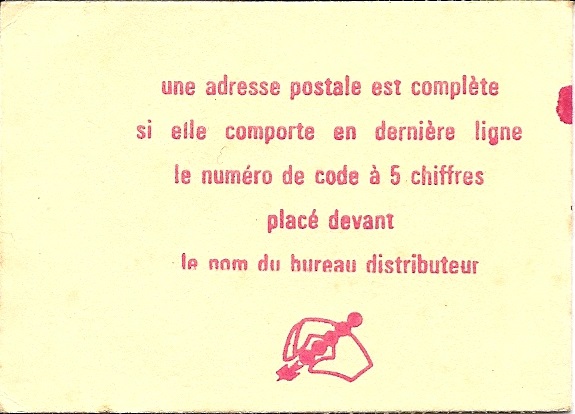
- C9 booklet produced by the packaging machine without number
Here is finally a C9 type booklet with type B phosphor bands similar to the booklet C9 with type A phosphor bands shown above: the upper pane has phosphor bands very wide and horizontally and vertically shifted, giving two stamps with one and a half phosphor bands, eight stamps with four phosphor bands and phosphor bands in the left margin; the lower pane, on the other hand, is normal:
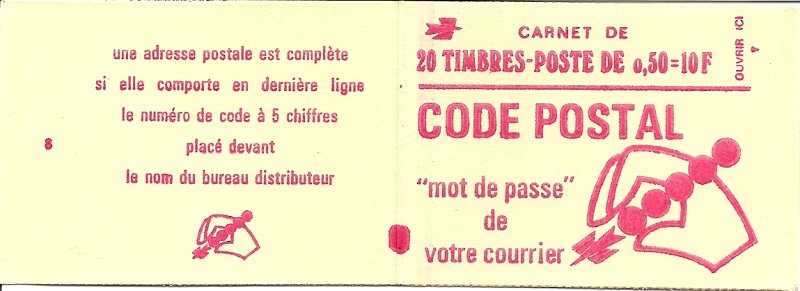
- cover of a C9 booklet produced on the packaging machine number 8
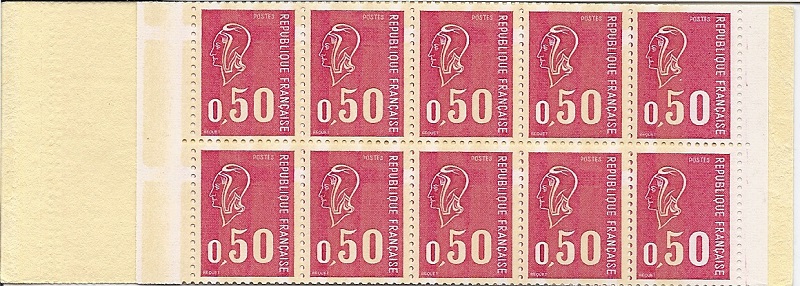
- upper pane of the previous booklet: the offset large phosphor bands can be seen on the left margin
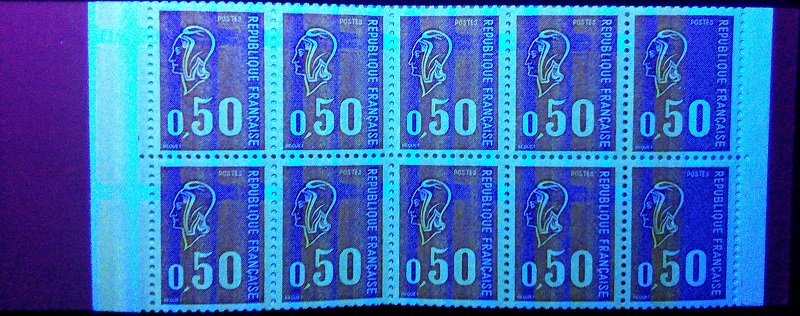
- photo under UV of the above booklet
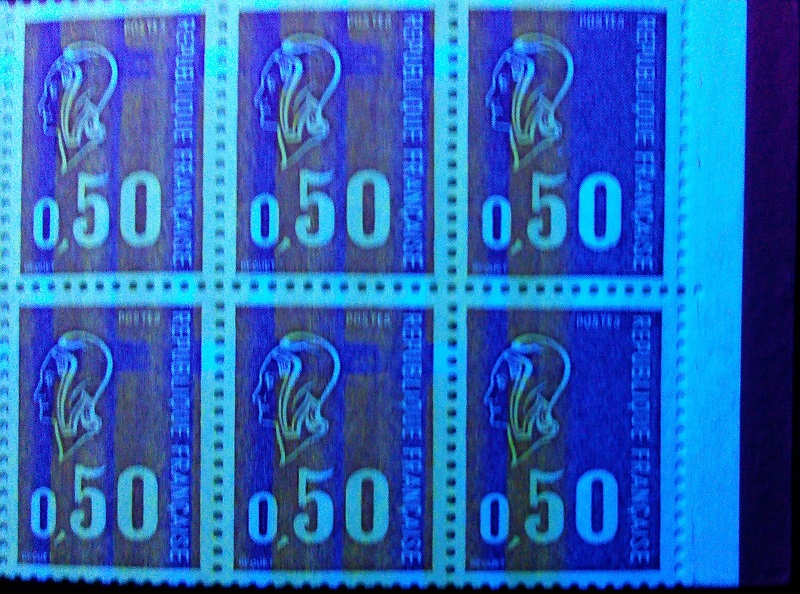
- enlargement of the above booklet under U.V. showing 2 stamps with 1 phosphor band and a half and stamps with 4 phosphor bands
The C10 type booklet
It is a booklet of 20 stamps with three type B phosphor bands and a cover advertising the use of the 5-digit zip code, with dotted lines:
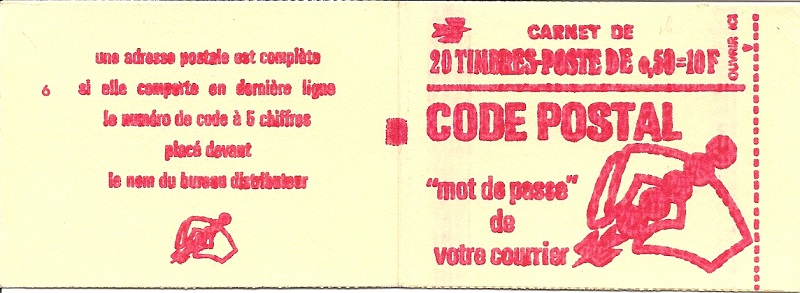
- cover of the C10 booklet produced by the packing machine number 6
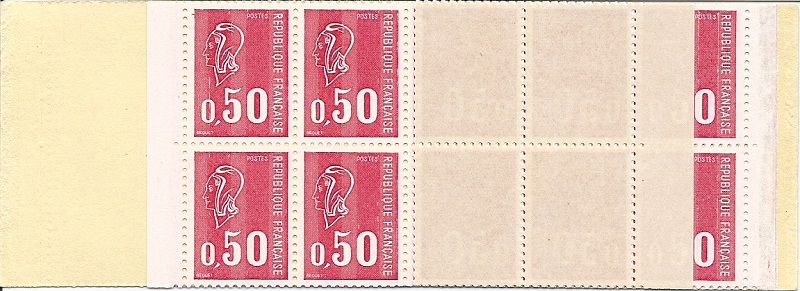
- inside of the above booklet
C10 type booklets were produced from 14.05.74 to 24.07.74 on the press TD6-7. Covers were only printed by means of the packaging machine number 6.
To end this part on the description of booklets containing stamps 0,50F Marianne de Béquet, I would like to show a rather unusual pane of booklet:
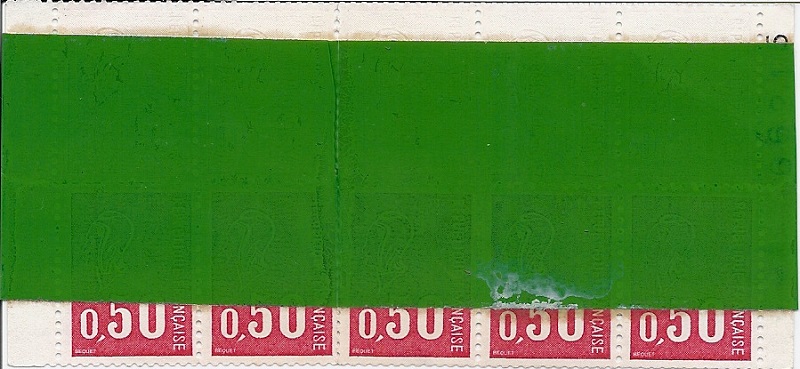
- pane of a 20 stamps booklet with a green Scotch tape connection
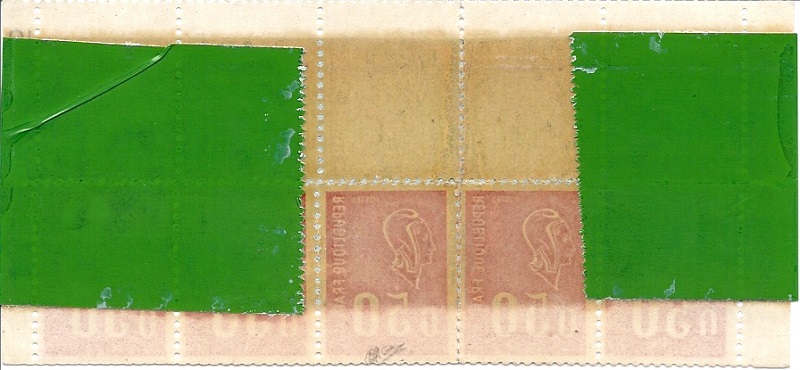
- reverse side of the above pane
It is a booklet pane reconstituted with a green Scotch tape connection. The top of the pane is made up of a strip of 5 albinos and the bottom of a strip of 5 normally printed stamps. We may note that both strips are very slightly moved. According to a former employee of the I.T.V.F., it would be " a join of reels of stamps on the packaging machine to remove a part damaged during the line-engraving printing ". The driver of the machine would have put damaged items without covers in a special box intended for scrap pieces. But this pane of booklet would have escaped the destruction.
Test booklets
A number of test booklets with type 2 Palissy vignettes (size 18x22,5 mm, perforated 13x13) are known. These booklets were produced for the manufacturing of booklets or the adjustment of stamp vending machines (cf. the brochure Les carnets d’essais de G. GOMEZ):

- type C1 test booklet of 10 steel-blue Palissy stamps

- cover of the above booklet produced on the packaging machine number 5

- type C1 test booklet of 10 green Palissy stamps

- cover of the above booklet produced on the packaging machine number 5

- type C4 or C8 test booklet of 10 purple Palissy stamps

- cover of the above booklet produced on the packaging machine number 1
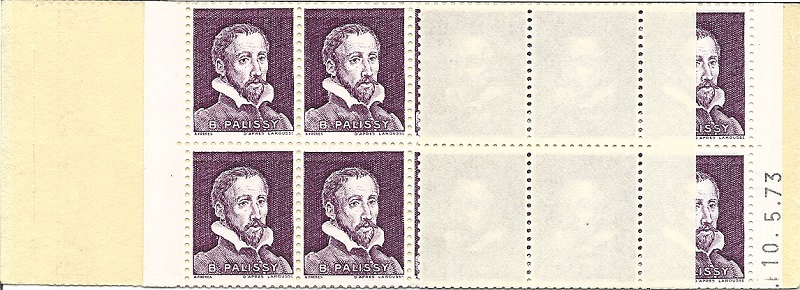
- type C5 or C9 test booklet of 20 purple Palissy stamps
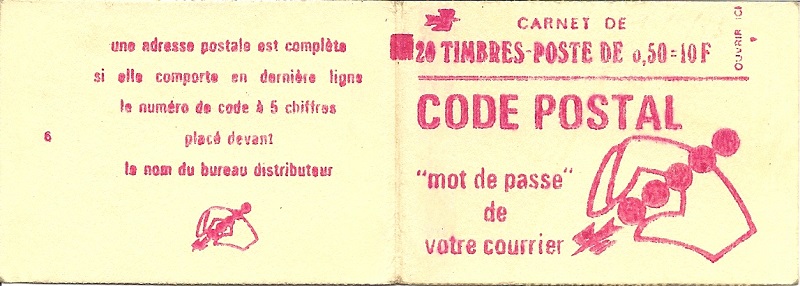
- cover of the above booklet produced on the packaging machine number 6
Booklets for the PTTs postal courses
Two types of booklets, without a stamp, were made for the PTTs postal courses during the period of the stamp 0,50F Marianne de Béquet. They were used by the pupils of postal worker courses to proceed to the counting of their sub-cash register, but were also intended for the adjustment of cutting machines or of booklet vending machines (cf. the brochure Les carnets d’essais de G. GOMEZ):
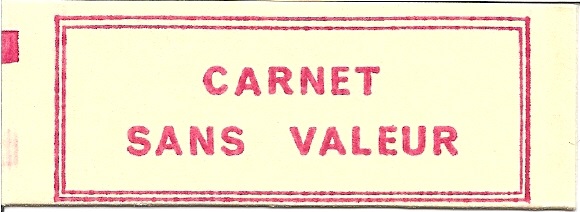
- booklet of 10 stamps for the PTTs postal courses
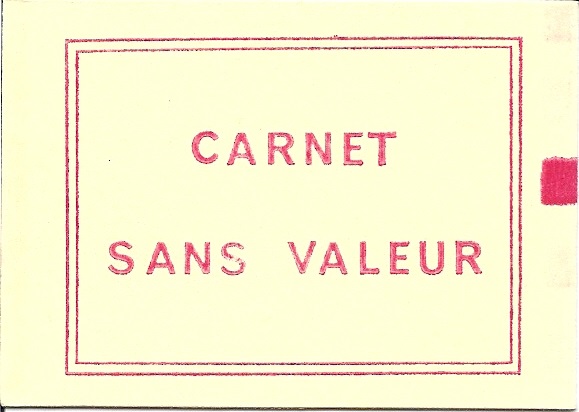
- booklet of 20 stamps for the PTTs postal courses
 Site map
Site map
 Contact
Contact
 Legal notices
Legal notices
 Editors area
Editors area


2015-2017 © Etude monographique du 0,50F Marianne de Béquet - All rights reserved


 Home
Home


